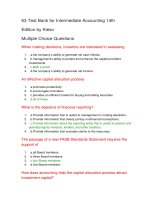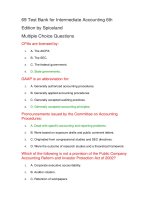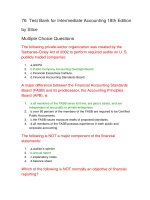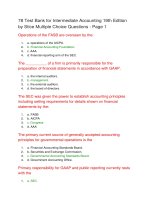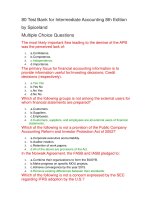132 test bank for intermediate accounting spiceland 7th edition
Bạn đang xem bản rút gọn của tài liệu. Xem và tải ngay bản đầy đủ của tài liệu tại đây (184 KB, 38 trang )
132 Test Bank for Intermediate Accounting Spiceland 7th
Edition
True False Questions - Free Text Questions - Multiple Choice Questions
True- False Questions
Auditors play an important role in the resource allocation process by adding
credibility to financial statements.
1.
True
2.
False
Accounting for stock-based compensation is an area in which the FASB has
received little political interference.
1.
True
2.
False
The FASB is currently the public-sector organization responsible for setting
accounting standards in the United States.
1.
True
2.
False
The purpose of the conceptual framework is to provide a structure and
framework for a consistent set of GAAP.
1.
True
2.
False
Accrual accounting attempts to measure revenues and expenses that
occurred during accounting periods so they equal net operating cash flow.
1.
True
2.
False
The FASB's conceptual framework lists relevance and timeliness as the two
fundamental qualitative characteristics of decision useful information.
1.
True
2.
False
The funding of the standard-setting bodies that promulgate IFRS is as
independent as that underlying U.S. GAAP.
1.
True
2.
False
The monetary unit assumption requires that items in financial statements be
measured in a particular monetary unit.
1.
True
2.
False
According to the FASB's Statements of Financial Accounting Concepts,
conservatism is a desired qualitative characteristic of accounting information.
1.
True
2.
False
The primary function of financial accounting is to provide relevant financial
information to parties external to business enterprises.
1.
True
2.
False
Comprehensive income is another term for net income.
1.
True
2.
False
The FASB's framework for measuring fair value doesn't change the situations
in which fair value is used under current GAAP.
1.
True
2.
False
Determining fair value by calculating the present value of future cash flows is
a level 1 type of input.
1.
True
2.
False
In IFRS, the conceptual framework indicates appropriate accounting when a
more specific accounting standard does not apply.
1.
True
2.
False
The Public Reform and Investor Protection Act of 2002 (Sarbanes-Oxley)
changed the entity responsible for setting auditing standards in the United
States.
1.
True
2.
False
The revenue/expense approach emphasizes determining the appropriate
amounts of revenue and expense in each reporting period.
1.
True
2.
False
In the United States the conceptual framework indicates GAAP when a more
specific accounting standard does not apply.
1.
True
2.
False
The periodicity assumption requires that present value calculations take into
account the number of compounding periods in each year.
1.
True
2.
False
Gains or losses result, respectively, from the disposition of business assets
for greater than, or less than, their book values.
1.
True
2.
False
Materiality can be affected by the dollar amount of an item, the nature of the
item, or both.
1.
True
2.
False
The FASB's due process invites various interested parties to indicate their
opinions about whether financial accounting standards should be changed.
1.
True
2.
False
The asset/liability approach emphasizes matching to determine what assets
and liabilities should be reflected on the balance sheet.
1.
True
2.
False
Revenues are inflows or other enhancements of assets or settlements of
liabilities from activities that constitute the entity's ongoing operations.
1.
True
2.
False
A rules-based approach to standard setting stresses professional judgment
as opposed to following a list of rules.
1.
True
2.
False
Equity is a residual amount representing the owner's interest in the assets of
the business.
1.
True
2.
False
Under federal securities laws, the SEC has the authority to set accounting
standards in the United States.
1.
True
2.
False
The primary responsibility for properly applying GAAP when communicating
with investors and creditors through financial statements lies with a firm's
auditors.
1.
True
2.
False
Mutiple Choice Questions- Page 1
The main issue in the debate over accounting for employee stock options
was:
1.
A. Which employees should receive options.
2.
B. The amount of compensation expense that a company should recognize.
3.
C. How many options should be granted to key executives.
4.
D. The tax consequences of employee stock options.
The possibility that the capital markets' focus on periodic profits may tempt a
company's management to bend or even break accounting rules to inflate
reported net income is an example of:
1.
A. An ethical dilemma.
2.
B. An accounting theory issue.
3.
C. A technical accounting issue.
4.
D. None of the above is correct.
SFAC No.5 focuses on:
1.
A. Objectives of financial reporting.
2.
B. Qualitative characteristics of accounting information.
3.
C. Recognition and measurement concepts in accounting.
4.
D. Elements of financial statements.
Phase A of the new conceptual framework focuses on:
1.
A. Objective and qualitative characteristics.
2.
B. Presentation and disclosure.
3.
C. Recognition and measurement.
4.
D. Elements of financial statements.
In a recent annual report, Apple Computer reported the following in one of its
disclosure notes: "Warranty Expense: The Company provides currently for
the estimated cost for product warranties at the time the related revenue is
recognized." This note exemplifies Apple's use of:
1.
A. Conservatism.
2.
B. The matching principle.
3.
C. Realization principle.
4.
D. Economic entity.
Which of the following groups is not among the external users for whom
financial statements are prepared?
1.
A. Customers.
2.
B. Suppliers.
3.
C. Employees.
4.
D. All of the above are external users of financial statements.
"Condorsement":
1.
A. Is a term used by the IASB to refer to the conditional endorsement process used by
the EU with respect to IFRS.
2.
B. Describes a combination of convergence and endorsement that the SEC suggested
the United States might use in the future to incorporate IFRS into U.S. GAAP.
3.
C. Was coined by a representative of the AICPA to describe the lengthy convergence
process.
4.
D. Has nothing to do with the convergence process.
When a registrant company submits its annual filing to the SEC, it uses:
1.
A. Form 10-A.
2.
B. Form 10-K.
3.
C. Form 10-Q.
4.
D. Form S-1.
GAAP is an abbreviation for:
1.
A. Generally authorized accounting procedures.
2.
B. Generally applied accounting procedures.
3.
C. Generally accepted auditing practices.
4.
D. Generally accepted accounting principles.
Independent auditors express an opinion on the:
1.
A. Fairness of financial statements.
2.
B. Accuracy of financial statements.
3.
C. Soundness of a company's future.
4.
D. Quality of a company's management.
The primary professional organization for those accountants working in the
industry is the:
1.
A. AAA.
2.
B. AICPA.
3.
C. IIA.
4.
D. IMA.
CPAs are licensed by:
1.
A. The AICPA.
2.
B. The SEC.
3.
C. The federal government.
4.
D. State governments.
Which of the following does not apply to secondary markets?
1.
A. Transactions are important to the efficient allocation of resources in our economy.
2.
B. New resources are provided when shares of stock are sold by the corporation to the
initial owners.
3.
C. Transactions help to establish market prices for additional shares that may be
issued in the future.
4.
D. Many investors might be unwilling to provide resources to corporations if there is no
available mechanism for the future sale of their stocks and bonds to others.
Accounting standard setting has been characterized as:
1.
A. A political process.
2.
B. Using the scientific method.
3.
C. Pure deductive reasoning.
4.
D. Pure inductive reasoning.
Pronouncements issued by the Committee on Accounting Procedures:
1.
A. Dealt with specific accounting and reporting problems.
2.
B. Were based on exposure drafts and public comment letters.
3.
C. Originated from congressional studies and SEC directives.
4.
D. Were the outcome of research studies and a theoretical framework.
The most recent example of the political process at work in standard setting is
the heated debate that occurred on the issue of:
1.
A. Pension plan accounting.
2.
B. Accounting for postretirement benefits other than pensions.
3.
C. Accounting for business combinations.
4.
D. Accounting for stock-based compensation.
The most likely important flaw leading to the demise of the APB was the
perceived lack of:
1.
A. Confidence.
2.
B. Competence.
3.
C. Independence.
4.
D. Importance.
The FASB's standard-setting process includes, in the correct order:
1.
A. Exposure draft, research, discussion paper, Accounting Standards Update.
2.
B. Research, exposure draft, discussion paper, Accounting Standards Update.
3.
C. Research, discussion paper, exposure draft, Accounting Standards Update.
4.
D. Discussion paper, research, exposure draft, Accounting Standards Update.
The FASB's conceptual framework's qualitative characteristics of accounting
information include:
1.
A. Historical cost.
2.
B. Realization.
3.
C. Faithful representation.
4.
D. Full disclosure.
Porite Company recognizes revenue in the period in which it records an asset
for the related account receivable, rather than in the period in which the
account receivable is collected in cash. Porite's practice is an example of:
1.
A. Cash basis accounting.
2.
B. Accrual accounting.
3.
C. The matching principle.
4.
D. Economic entity.
The International Accounting Standards Board:
1.
A. Was the predecessor to the IASC.
2.
B. Can overrule the FASB when their policies disagree.
3.
C. Promotes the use of high-quality, understandable global accounting standards.
4.
D. Has its headquarters in Geneva.
Which of the following is not true about net operating cash flow?
1.
A. It is the difference between cash receipts and cash disbursements from providing
goods and services.
2.
B. It is a measure used in accrual accounting and is recognized as the best predictor of
future operating cash flows.
3.
C. Over short periods, it may not be indicative of long-run cash-generating ability.
4.
D. It is easy to understand and all information required to measure it is factual.
The conceptual framework's qualitative characteristic of relevance includes:
1.
A. Predictive value.
2.
B. Verifiability.
3.
C. Completeness.
4.
D. Neutrality.
The most political issue in the FASB's most recent deliberations and
amendments to GAAP on business combinations was:
1.
A. The negative effects on subsequent earnings of amortizing goodwill if firms were
required to use the purchase method of accounting for the combination.
2.
B. The negative effects on subsequent earnings of amortizing goodwill if firms were
required to use the pooling method of accounting for the combination.
3.
C. The unrealistic balance sheet assets that would be created if firms were required to
use the purchase method of accounting for the combination.
4.
D. The unrealistic balance sheet assets that would be created if firms were required to
use the pooling method of accounting for the combination.
One of the elements that many believe distinguishes a profession from other
occupations is the acceptance of responsibility by its members for the
interests of those it serves, which is often articulated in:
1.
A. Its conceptual framework.
2.
B. Its code of ethics.
3.
C. Federal laws.
4.
D. State laws.
Which of the following was the first private-sector entity that set accounting
standards in the United States?
1.
A. Accounting Principles Board.
2.
B. Committee on Accounting Procedure.
3.
C. Financial Accounting Standards Board.
4.
D. AICPA.
Which of the following groups is not among financial intermediaries?
1.
A. Mutual fund managers.
2.
B. Financial analysts.
3.
C. CPAs.
4.
D. Credit rating organizations.
Which of the following is not a potential benefit of accrual accounting,
compared to cash-basis accounting?
1.
A. Timeliness.
2.
B. Better reflecting economic activity.
3.
C. Periodicity.
4.
D. Better matching of revenues and expenses.
The FASB's conceptual framework's qualitative characteristics of accounting
information include:
1.
A. Full disclosure.
2.
B. Relevance.
3.
C. Going concern.
4.
D. Historical cost.
The conceptual framework's qualitative characteristic of faithful
representation includes:
1.
A. Predictive value.
2.
B. Neutrality.
3.
C. Confirmatory value.
4.
D. Timeliness.
Which of the following is not a provision of the Public Company Accounting
Reform and Investor Protection Act of 2002?
1.
A. Corporate executive accountability.
2.
B. Auditor rotation.
3.
C. Retention of work papers.
4.
D. All of the above are provisions of the Act.
The FASB issues accounting standards in the form of:
1.
A. Accounting Research Bulletins.
2.
B. Accounting Standards Updates.
3.
C. Financial Accounting Standards.
4.
D. Financial Technical Bulletins.
Which of the following has the statutory authority to set accounting standards
in the United States?
1.
A. FASB.
2.
B. IRS.
3.
C. SEC.
4.
D. AICPA.
A firm's comprehensive income always:
1.
A. Is the same as its net income.
2.
B. Is greater than its net income.
3.
C. Is less than its net income.
4.
D. Could be greater than or less than net income.
The primary historical reason for the FASB reversing its positions when
political pressures occur is:
1.
A. The cost of gathering data was prohibitive.
2.
B. The difficulties in measurement were too great.
3.
C. They have no authority in such situations.
4.
D. The SEC did not support the FASB position.
External decision makers would not look primarily to financial accounting
information to assist them in making decisions on:
1.
A. Granting credit.
2.
B. Capital budgeting.
3.
C. Selecting stocks.
4.
D. Mergers and acquisitions.
Which of the following is not a provision of the Public Company Accounting
Reform and Investor Protection Act of 2002 (Sarbanes-Oxley)? The Act:
1.
A. Changed the entity responsible for setting auditing standards.
2.
B. Increased corporate executive responsibility for financial statements.
3.
C. Limited nonaudit services that can be performed by auditors for audit clients.
4.
D. Changed the entity responsible for setting accounting standards.
Corporations issue their shares to the investing public in the: option a:
Primary market: Yes, Secondary market: yes; option b: Primary market: no,
Secondary market: yes; option c: Primary market: Yes, Secondary market: no;
option d: Primary market: no, Secondary market: no.
1.
A. Option a
2.
B. Option b
3.
C. Option c
4.
D. Option d
The primary focus for financial accounting information is to provide
information useful for: option a: Investing decisions: Yes, Credit Decisions:
yes; option b: Investing decisions: Yes, Credit Decisions: no; option c:
Investing decisions: no, Credit Decisions: yes;option d: Investing decisions:
no, Credit Decisions: no.
1.
A. Option a
2.
B. Option b
3.
C. Option c
4.
D. Option d
In the Norwalk Agreement, the FASB and IASB pledged to:
1.
A. Combine their organizations to form the BUSYB.
2.
B. Make progress on specific MOU projects.
3.
C. Achieve convergence by the year 2015.
4.
D. Remove existing differences between their standards.
80 Free Test Bank for Intermediate Accounting 7th
Edition by Spiceland Mutiple Choice Questions- Page 2
Under IFRS, the conceptual framework:
1.
A. Emphasizes the overarching concept of the financial statements providing a "true
and fair representation" of the company.
2.
B. Is not designed to provide guidance to standard setters, but rather only to
practitioners.
3.
C. Is not designed to provide guidance to practitioners, but rather only to standard
setters.
4.
D. Specifies a set of rules that determine what constitutes a true IFRS standard.
Recognizing expected losses immediately, but deferring expected gains, is an
example of:
1.
A. Materiality.
2.
B. Conservatism.
3.
C. Cost-effectiveness.
4.
D. Timeliness.
The conceptual framework's recognition and measurement concepts
recognize which of the following as an assumption, rather than a principle?
1.
A. Going concern.
2.
B. Historical cost.
3.
C. Full disclosure.
4.
D. Realization.
Constraints on qualitative characteristics of accounting information include:
1.
A. Timeliness.
2.
B. Going concern.
3.
C. Neutrality.
4.
D. Cost-effectiveness.
The recognition of which of the following expenses exemplifies the
application of the matching principle?
1.
A. President's salary.
2.
B. Research and development.
3.
C. Cost of goods sold.
4.
D. Advertising.
Mega Loan Company has very stringent credit requirements and, accordingly,
has negligible losses from uncollectible accounts. The company's
independent accountants did not protest when, contrary to GAAP, the
company recorded bad debt expense only when specific accounts were
determined to be uncollectible, rather than use an allowance for uncollectible
accounts. The concept demonstrated is:
1.
A. Comparability.
2.
B. Faithful representation.
3.
C. Cost-effectiveness.
4.
D. Materiality.
Change in equity from nonowner sources is:
1.
A. Comprehensive income.
2.
B. Revenues.
3.
C. Expenses.
4.
D. Gains and losses.
According to the conceptual framework, verifiability implies:
1.
A. Legal evidence.
2.
B. Logic.
3.
C. Consensus.
4.
D. Legal verdict.
Net income equals:
1.
A. Assets minus liabilities.
2.
B. Revenues minus cost of goods sold.
3.
C. Revenues minus expenses.
4.
D. Cash receipts minus cash payments.
The matching principle is:
1.
A. A valuation method.
2.
B. An expense recognition accounting principle.
3.
C. A cash basis reporting principle.
4.
D. An asset classification procedure.
Disclosure notes to a company's financial statements:
1.
A. Are relatively unimportant facts that don't belong in the basic financial statements.
2.
B. Document the source of financial statement facts, like literary footnotes.
3.
C. Are an integral part of a company's financial statements.
4.
D. Are irrelevant facts that are immaterial in amount.
Elements of financial statements do not include:
1.
A. Monetary unit.
2.
B. Investments by owners.
3.
C. Comprehensive income.
4.
D. Losses.
The full disclosure principle requires a balance between:
1.
A. Comparability and consistency.
2.
B. Relevance and cost-effectiveness.
3.
C. Reliability and neutrality.
4.
D. Timeliness and predictive value.
Gains are:
1.
A. Inflows from selling a product or service to a customer.
2.
B. Increases in equity resulting from transfers of assets to the company from owners.
3.
C. Increases in equity from peripheral transactions of an entity.
4.
D. None of the above is correct.
Which of the following is typically characterized as a principle, rather than an
assumption?
1.
A. Periodicity.
2.
B. Monetary unit.
3.
C. Conservatism.
4.
D. Full disclosure.
The revenue/expense approach emphasizes:
1.
A. Recognition of revenues (typically applying the realization principle).
2.
B. Recognition of expenses (typically applying the matching principle).
3.
C. The income statement.
4.
D. All of the above are correct.
Enhancing qualitative characteristics of accounting information include each
of the following except:
1.
A. Timeliness.
2.
B. Materiality.
3.
C. Comparability.
4.
D. Verifiability.
Surefeet Corporation changed its inventory valuation method. Which
characteristic is jeopardized by this change?
1.
A. Comparability.
2.
B. Representational faithfulness.
3.
C. Consistency.
4.
D. Feedback value.
Which of the following is not an identified valuation technique in GAAP
regarding fair value measurement?
1.
A. Cost approach.
2.
B. Market approach.
3.
C. Cost-benefit approach.
4.
D. Income approach.
To meet the needs of full disclosure, companies use supplemental
information, including:
1.
A. Parenthetical comments or modifying comments placed on the face of the financial
statements.
2.
B. Disclosure notes conveying additional insights about company operations,
accounting principles, contractual agreements, and pending litigation.
3.
C. Supplemental financial statements that report more detailed information than is
shown in the primary financial statements.
4.
D. All of the above are correct.
Which of the following best demonstrates the full disclosure principle?
1.
A. The multi-step income statement.
2.
B. The auditors' report.
3.
C. The company's tax return.
4.
D. Disclosure notes to financial statements.
Primecoat Corporation could disseminate its annual financial statements two
days earlier if it shifted substantial human resources from other operations to
the annual report project. Management decided the value of the earlier report
was not worth the added commitment of resources. The concept
demonstrated is:
1.
A. Timeliness.
2.
B. Materiality.
3.
C. Relevance.
4.
D. Cost-effectiveness.
Which of the following Statements of Financial Accounting Concepts defines
the 10 elements of financial statements?
1.
A. SFAC 4.
2.
B. SFAC 3.
3.
C. SFAC 5.
4.
D. SFAC 6.


